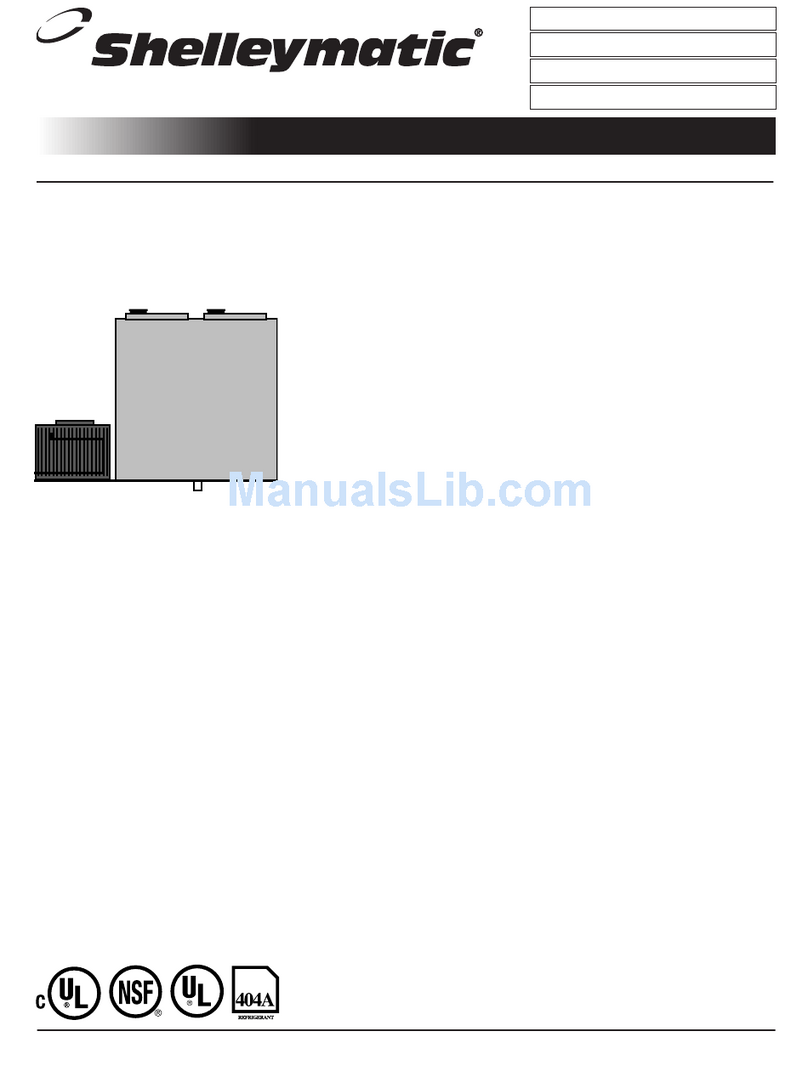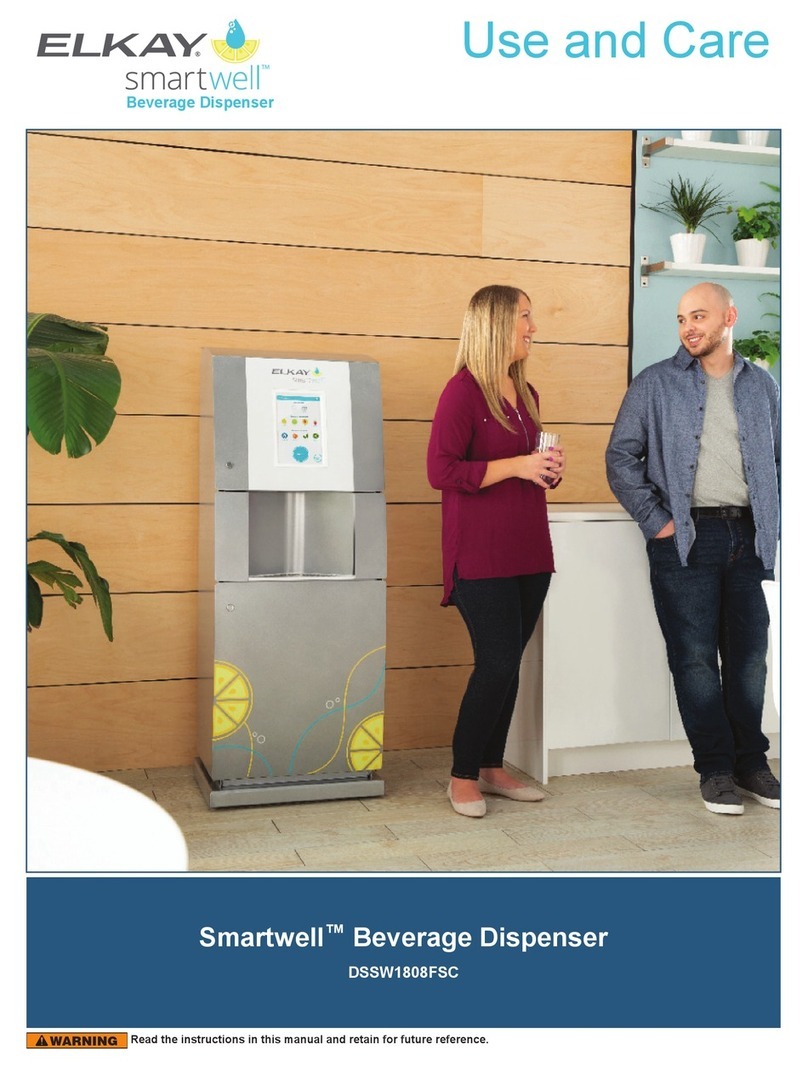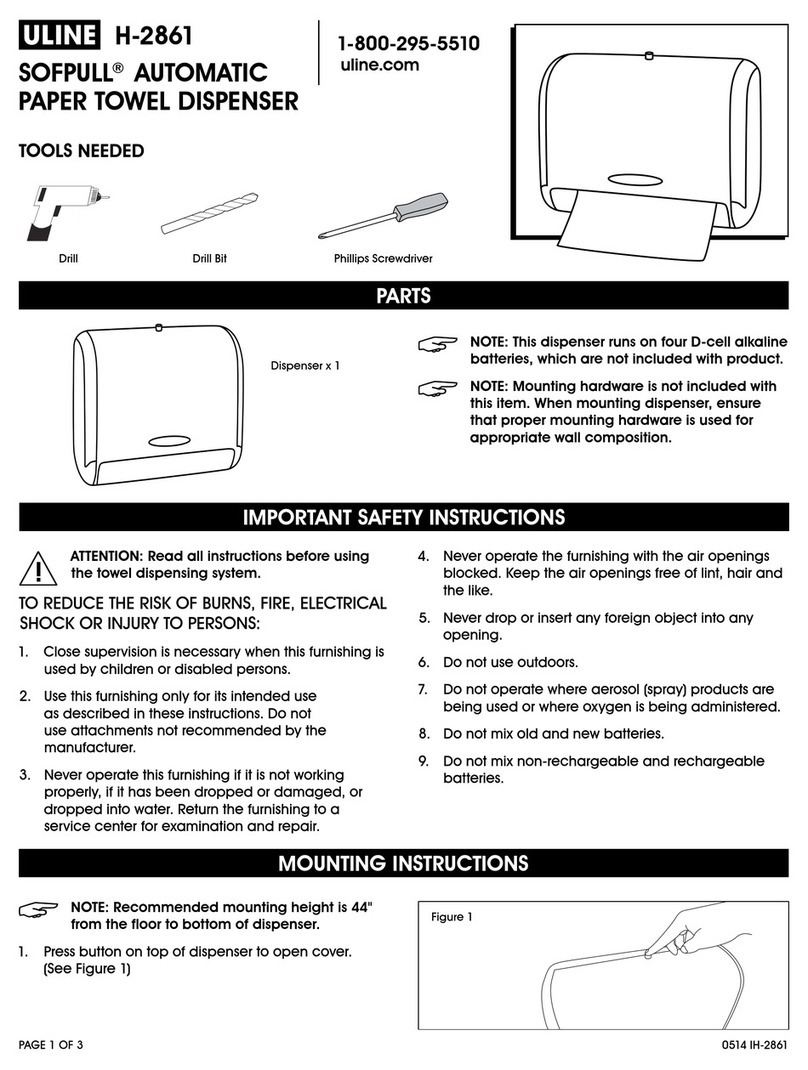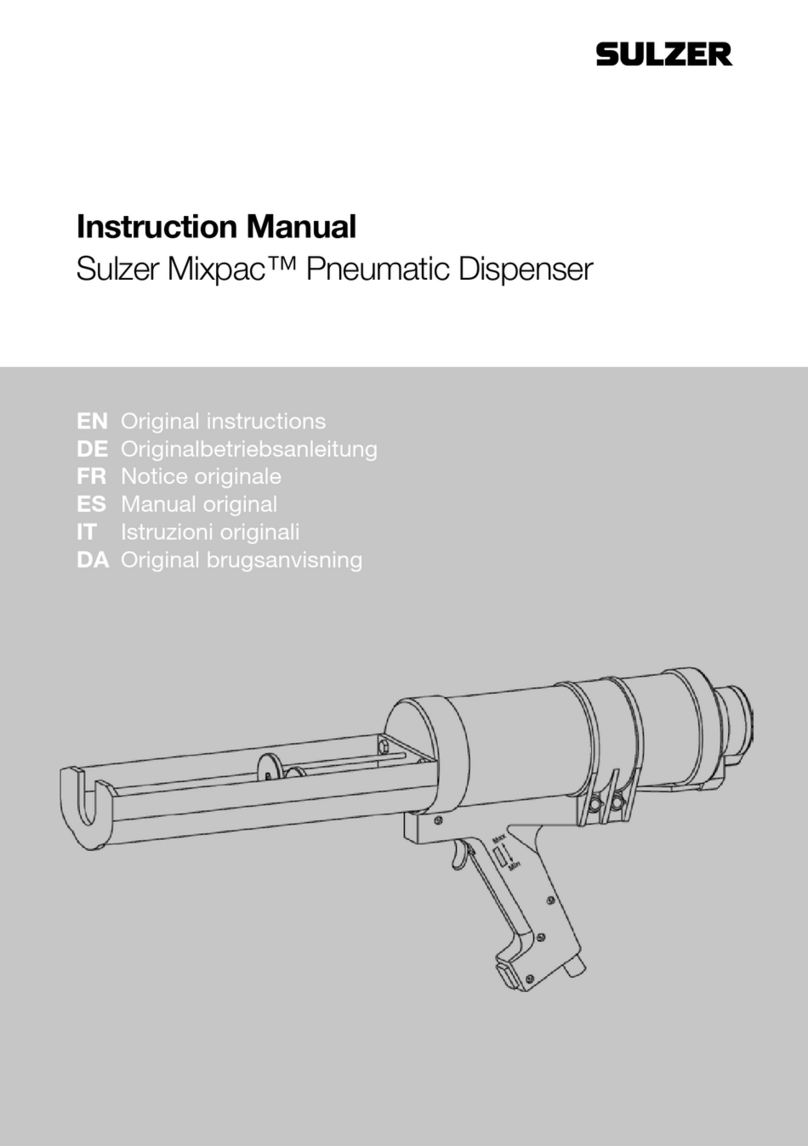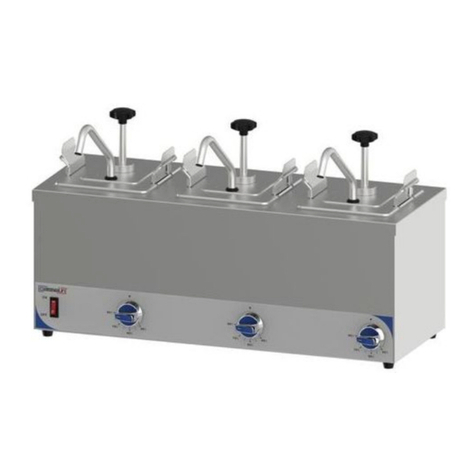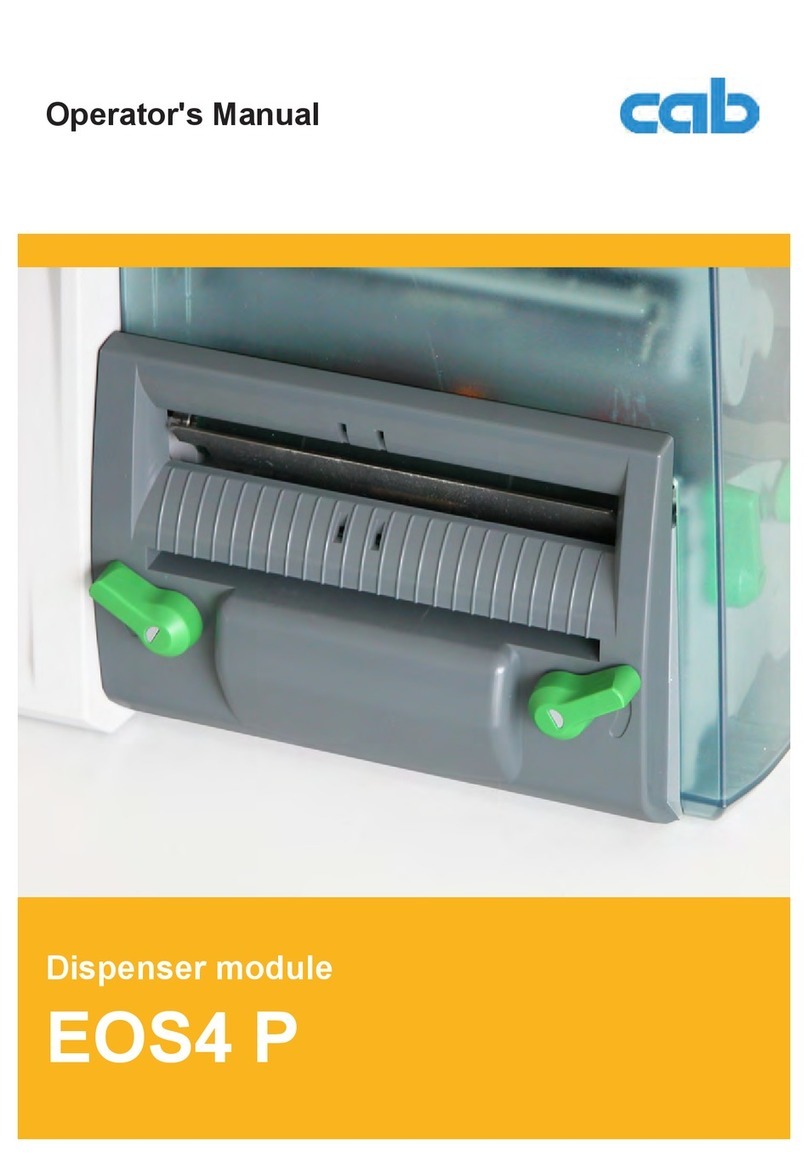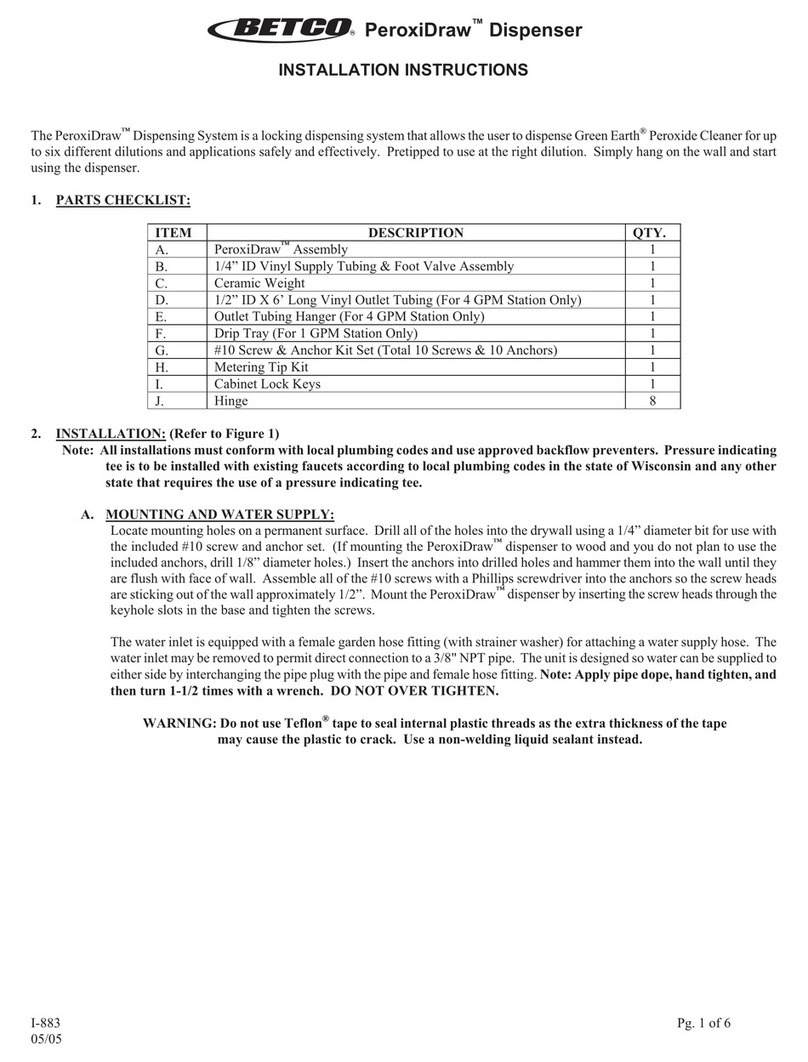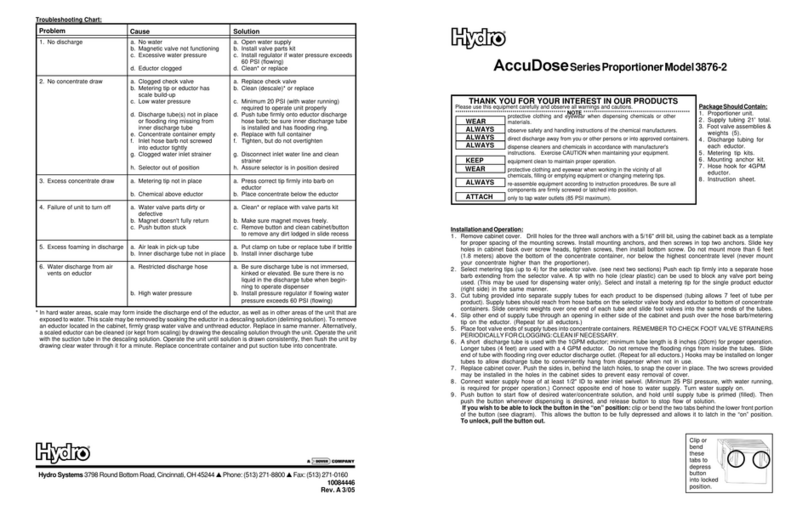BATCHEN COMMANDER II User guide

BATCHEN
COMMANDER II & CONCEPT 2000
LP Gas DISPENSERS
INSTALLER'S MANUAL
For Models: CII-SCE, CII-DCE, CII-SWE, CII-DWE
& C2000-SE, C2000-DE
(updated Ref:010220JV02)
(updated Ref:011102JV01)
QMAN-0043 Revision A
Printed: 19 January 2010

©D.J. BATCHEN Pty Ltd 1995
All rights reserved.
No part of this manual may be copied or reproduced in any form or by any means without
the prior written consent of D.J. Batchen Pty Ltd.
Whilst every care has been taken in the preparation of this manual to ensure that the
information in it is accurate and comprehensive, D.J. Batchen Pty Ltd assumes no
responsibility for any errors or omissions.
The information contained in this manual is subject to change without notice.

BATCHEN
Issue Date 2/11/01 QMAN0043 Installers Manual CII & C2000 Rev A.doc - 3 -
TABLE OF CONTENTS
1. WARNINGS
2. INTRODUCTION
3. TERMINOLOGY
4. SITE REQUIREMENTS & PREPARATION
5. DISPENSER INSTALLATION
6. DISPENSER COMMISSIONING
7. INSTALLATION REPORTING
8. INSTALLATION ACCESSORIES & TOOLS
9. DISPENSER SPECIFICATIONS
10. TECHNICAL DRAWINGS
APPENDIX - EXCERPT FROM EMAIL VISION MANUAL

BATCHEN
Issue Date 2/11/01 QMAN0043 Installers Manual CII & C2000 Rev A.doc - 4 -
PART 1 WARNINGS
WARNING
This equipment is designed to dispense Liquefied Petroleum Gas (LP Gas) to motor
vehicles. It contains flammable liquefied gas under pressure and must be installed and
serviced by persons trained and experienced in the safe handling of LP Gas, and in
accordance with all relevant local and statutory regulations, and recognised industry
procedures.
Failure to observe this warning may result in (but is not limited to):
* the escape of flammable liquid or vapour;
* explosion;
* fire; or
* freeze burns.
Note: Sudden, uncontrolled depressurisation may result in the propulsion of
components at high velocity.
WARNING
Do not latch the nozzle in the open position.
If there is a leak at the nozzle and it is latched open, the nozzle cannot be shut off
with out risk of freeze burns.
Incorrect connection or disconnection, or insufficient tightening of the nozzle may
result in a substantial release of LP Gas when the trigger is operated.

BATCHEN
Issue Date 2/11/01 QMAN0043 Installers Manual CII & C2000 Rev A.doc - 5 -
WARNING
The Batchen Commander is designed to refuel motor vehicles with LP Gas. Its use for
filling domestic cylinders may contravene local regulations as the gas dispensed may not
be suitable for domestic applications.
OPERATORS
Operators of this equipment should be fully trained in LP Gas refueling and emergency
procedures as set out in AS1596 "SAA LP Gas Storage and Handling" Code. All
operations must be carried out by authorised personnel in accordance with relevant local
and statutory regulations.

BATCHEN
Issue Date 2/11/01 QMAN0043 Installers Manual CII & C2000 Rev A.doc - 6 -
PART 2 INTRODUCTION
This manual is intended to provide information relating to the site preparation,
installation and commissioning of the Batchen Commander II and Concept 2000 series
of LP Gas Dispensers. The information is intended for use by suitably trained and
experienced Autogas installation personnel, and those involved in the planning of
Autogas installations.
Installation of the dispenser other than as specified in this manual may compromise safe
operation of the dispenser. If in doubt about any aspect of the installation procedure,
contact your local Batchen representative before proceeding.
It is assumed that all storage tanks, pipework and electrical wiring have been installed in
accordance with local requirements.
A knowledge of relevant standards, statutory requirements and local government
regulations is assumed.
Note: In this manual reference is made to relevant Australian Standards and
regulations. Where the dispenser is being installed outside Australia these
standards will still provide a guide to good engineering practice and copies can
be made available if required. However, it is important that the installer ensures
that the installation complies with local regulations wherever applicable.
Additional relevant information may be found in the associated Operator's and Service
manuals (see Installation Accessories & Tools section for details).

BATCHEN
Issue Date 2/11/01 QMAN0043 Installers Manual CII & C2000 Rev A.doc - 7 -
PART 3 TERMINOLOGY
Authorise Confirmation from console to dispenser that sale may proceed.
Autogas LP Gas used as a motor vehicle fuel.
Boot, Reboot When referring to dispenser processor - starting/restarting the
processor.
DIP Switch Multi-pole PCB mounted switch, used for setting dispenser
configuration.
Dual Dispenser Two hoses per dispenser, two displays per side.
Duo Dispenser Two hoses per dispenser, one display per side.
Fatal Error Error causing an automatic dispenser/hose shutdown.
K-Factor Dispenser calibration factor.
LED Light Emitting Diode.
LP Gas Liquefied Petroleum Gas.
PCB Printed Circuit Board assembly.
Pre-authorised Console configured so dispenser in a permanently authorised state.
RAM Random Access Memory.
RFI Radio Frequency Interference.
Self-serve Control & monitoring of dispenser operation from remote console.
Side A The side of the dispenser facing you when dispenser is viewed with
the (major) column/Compliance Plate/nozzle receptacles on the
left.
Side B The side of the dispenser facing you when dispenser is viewed with
the (major) column/Compliance Plate/nozzle receptacles on the
right.
Single Dispenser One hose per dispenser.
Special Segments Centre section of main display, not normally visible; used to
display status and error messages.

BATCHEN
Issue Date 2/11/01 QMAN0043 Installers Manual CII & C2000 Rev A.doc - 8 -
Stand-alone Mode Refers to dispenser set up to operate independently of console.
SWA Cable Steel Wire Armoured Cable.
Toggle Alternate from one state to next.

BATCHEN
Issue Date 2/11/01 QMAN0043 Installers Manual CII & C2000 Rev A.doc - 9 -
PART 4 SITE REQUIREMENTS & PREPARATION
4.1 General
Batchen LP Gas dispensers can be installed on any new or existing Autogas site,
attended or self-serve, provided the site complies with the following requirements:
* The location of the dispenser and associated equipment should be in accordance
with AS1596, AS1596 - Supplement 1: Siting of LP Gas Automotive Retail
Outlets and AS2430.3.
* The pipe work installation should comply with AS2229.2 and AS1596.
* The electrical installation should comply with AS2229.2 and AS3000.
* If part of a self-serve system, the Console should be located such that the
operator has an unobstructed view of all fuelling positions.
Note: It is the installer's responsibility to inform the owner/site operator of regulatory
requirements. Contact your local Batchen representative if additional
information is required.
Note: Multiple holes are provided in the dispenser base for flexibility in matching
mounting bolts to existing dispenser bases.
Note: Spool pieces can be provided to adapt dispenser flange positions to existing site
pipe work. Contact your local Batchen representative for details.
4.2 Electrical Cabling
Note: The mains power supply requirements of the Dispenser (Voltage, Current,
Frequency) are specified on the Dispenser Compliance Plate.
Note: All electrical cabling must comply with AS2229.2 and AS3000.
Note: The Dispenser incorporates the facility to control the operation of a remote
Pump.
Note: The Dispenser may be connected to a remote Console for controlling and
recording transactions. If this facility ("self-serve") is required a
communications cable must be provided.

BATCHEN
Issue Date 2/11/01 QMAN0043 Installers Manual CII & C2000 Rev A.doc - 10 -
A number of different methods may be used to make electrical connection to the
Dispenser:
* SWA cables buried underground - one cable for mains and another shielded
cable for dispenser communications.
* Two conduits - one containing the mains cable and the other containing the
shielded dispenser communications cable (the latter only required if self-serve).
* One conduit - containing both the mains cable and the shielded dispenser
communications cable (the latter only required if self-serve).
The cables required are as follows:
APPLICATION MAINS + PUMP CONTROL
COMMUNICATIONS
Stand-alone 1 x 4 core, 2.5 mm
2
Not required
Self-serve 1 x 4 core, 2.5 mm
2
1 x 2 core + Shield,
1.5 mm
2
Note: Cable runs greater than 20 metres may require an increase in cable size.
Note: When replacing an existing dispenser ensure that conduit and SWA cables are
terminated in the proper manner.
Note: While a stand-alone dispenser does not require provision of the communications
cable, it may be advisable to install the cable at this time to facilitate later
conversion to self-serve.
4.3 Emergency Shutdown System
AS1596 requires that the site be provided with an Emergency Shutdown System, the
operation of which includes removing mains power from the Dispenser/s and closing the
remote-operated valves located under the dispenser.

BATCHEN
Issue Date 2/11/01 QMAN0043 Installers Manual CII & C2000 Rev A.doc - 11 -
4.4 Pipework
All pipework should comply with AS1596 and AS2229.2.
In particular, the following should be provided as a minimum:
* An appropriately rated Excess Flow Valve should be fitted to the Liquid Inlet line.
* A remote-operated Shut-off Valve should be fitted to the Liquid Inlet line; the
design of the valve should be such that it will shut in the event of the energising
medium failing.
* A Shear Point on the pipe work at the base of the dispenser.
The valves should be installed below or as close as possible to ground level, with the shear
point above them. Where the remote-operated valve can be relied on to close in the event
of pipe shear, the excess flow valve may be omitted.
Batchen dispensers are supplied as standard with the flanged external hydraulic
connections:
* Liquid inlet flange: 32 mm x Class 300 ANSI
* Vapour return flange: 20 mm x Class 300 ANSI
Drawings DJB-0859 or DJB-1127 shows the location of flanges with respect to the
Dispenser Base.
The pipework under the dispenser should be made up to match the Dispenser flanges. The
flanges must be level in both horizontal axes.
Note: Alternative flange sizes, or spool pieces to match different flange locations, can be
provided if required; see your local Batchen representative for details.
4.5 Dispenser Base
It is recommended that a pre-fabricated steel base set into concrete be used to mount the
dispenser.
This should be installed such that the surface for mounting the dispenser is a minimum of
50 mm above ground level, with concrete paving sloping away from the base.
A number of optional hole positions are provided in the Dispenser Frame for mounting
bolts; these various options are shown on drawings DJB-0859 or DJB-1127. Four
attachment bolts should be used - 1/2" x 2 1/2" or M14 x 65 mm.

BATCHEN
Issue Date 2/11/01 QMAN0043 Installers Manual CII & C2000 Rev A.doc - 12 -
PART 5 DISPENSER INSTALLATION
WARNING
DO NOT SWITCH ON MAINS POWER TO DISPENSER BEFORE
COMPLETING PART 6.1 - INITIAL CHECK, AND PART 6.2 - DISPENSER
ELECTRONIC SETUP.
5.1 Dispenser Inspection
When the Dispenser arrives on site, the shipping carton should be removed and the
Dispenser inspected for damage. If damage is evident, it should be immediately
reported to the carrier and your local Batchen representative for insurance purposes.
5.2 Dispenser Preparation
Before commencing the installation of the dispenser at least the hydraulics cabinet
panels should be removed to prevent damage during the installation.
5.3 Dispenser Lifting
WARNING
LIFTING THE DISPENSER OTHER THAN AS DESCRIBED RISKS
SERIOUS DAMAGE TO THE DISPENSER AND PERSONNEL INVOLVED.
ON NO ACCOUNT SHOULD THE DISPENSER BE LIFTED BY PLACING A
SLING UNDER THE ELECTRONICS CABINET.
The dispenser may be lifted using a suitable forklift, crane or other mobile lifting
equipment. Lifting equipment used must have a capacity of at least 250 Kg.
* If a forklift is to be used, the tines of the forklift should be placed through the
pallet that the dispenser is mounted on for shipping.
* If a crane is to be used, a sling provided with a suitable protective cover to
prevent scratching should be used.
The sling should be placed under the top member of the hydraulics compartment
frame and then over the front faces of the electronics cabinet.
5.4 Positioning the Dispenser on the Dispenser Base

BATCHEN
Issue Date 2/11/01 QMAN0043 Installers Manual CII & C2000 Rev A.doc - 13 -
Position the dispenser on the base and check for correct alignment between:
* The chosen mounting bolt holes in the Dispenser Frame and the corresponding
holes in the Dispenser Base.
* The Liquid Inlet and Vapour Return flanges of the Dispenser and site pipework.
Correct any problem before proceeding.
5.5 Flange Connections and Dispenser Attachment Bolts
The Liquid Inlet and Vapour Return line flanges should be connected using a suitable
gasket (we recommend ??) and bolts. The bolts should be tightened to ??.
The dispenser baseplate bolts should be fitted and tightened to ??.
5.6 Fitting Hosemasts (Commander II only) and Hoses
5.6.1 Commander II
Step 1: Check that the Hosemast attachment bolt/s at the top of the (major)
column are tight. If not, remove the column cover and tighten.
Check that the column cap is in place.
Step 2: Locate the large plastic washer/s (shipped inside the electronics cabinet)
and place over the Hosemast attachment bolt/s.
Step 3: Remove the Hosemast/s from their packaging and screw onto the
attachment bolts. Tighten firmly by hand.
Step 4: Remove the Hose Assemblies from their packaging and connect the male
end of the Sentry 20 Hose Breakaway Coupling to the female end (see
instructions on the base of the column). Tighten retaining collar
correctly.
Step 5: Insert the pin of the Hose Support Clamp/s into the corresponding hole in
the top of the Hosemast/s. Push firmly until it snaps home.
Check for the correct location of the retaining circlip.
Step 6: Check that the Hose Support Clamp/s are located correctly on the hose/s
i.e. that the hose/s do not contact the ground, and that there is sufficient
length for the Nozzle/s to be inserted easily into the nozzle receptacle/s.

BATCHEN
Issue Date 2/11/01 QMAN0043 Installers Manual CII & C2000 Rev A.doc - 14 -
5.6.2 Concept 2000
Step 1: Remove the Hose Assemblies from their packaging and connect the male
end of the Sentry 20 Hose Breakaway Coupling to the female end (see
instructions on the base of the column). Tighten retaining collar
correctly.
Step 2: Use Ti-wrap/s and Hose Protection Sleeve/s (shipped inside the
electronics cabinet) to secure the Hose/s to the Hose Suspension Cables
at the top of the column.
Step 3: Check that the Hose support/s are positioned located correctly on the
hose/s i.e. that the hose/s do not contact the ground, and that there is
sufficient length for the Nozzle/s to be inserted easily into the nozzle
receptacle/s.
5.7 Field Wiring Tests
The following tests are designed to detect any faulty wiring which, if not corrected, may
cause injury, damage or faulty system operation.
These tests should be performed as specified by suitably qualified personnel.
5.7.1 Equipment Required
A 500 V "intrinsically safe" megger test unit.
Note: Any cable being tested should be completely disconnected from the Dispenser
and mains supply.
Note: After the test is completed the cables must be discharged to ground before any
connections are made to the Dispenser.
5.7.2 Megger Test
Perform megger tests on all wiring installed. The tests must be made between adjacent
conductors, and between each conductor and earth.
The minimum resistance should be 50 megohms.
Any faults found should be rectified and re-tested before proceeding.
5.8 Electrical Connection to Dispenser
All electrical connections to the dispenser are made via a terminal strip located in the
black plastic "Ex e" enclosure located at the Compliance Plate end of the hydraulics
cabinet (see DJB-0874).

BATCHEN
Issue Date 2/11/01 QMAN0043 Installers Manual CII & C2000 Rev A.doc - 15 -
Note: Before proceeding, the installer should familiarise himself with the dispenser
electrical schematic (see DJB-1176).
Note: Cable entries to the "Ex e" enclosure should be made through appropriate M20
glands that are suitable for the cable used (e.g. SWA cable requires a different
gland from TPS cable that is run in conduit).
The glands replace an M20 blanking plug and are not supplied with the
Dispenser.
Note: If a communication cable is not required the blanking plug must be left in place.
Note: SWA glands are provided with a facility for earthing the wire armour. This
should be connected to the earth busbar provided in the "Ex e" enclosure.
5.8.1 Terminating Cables
The junction box layout and method of terminating cables is shown in DJB-0874.
Note: The communications cable is not polarised. However the phasing must be
consistent with all other dispensers/pumps on the site.
Note: The outer insulation sleeve of cables should not be stripped back more than
necessary, and certainly no more than 20 mm.
Note: The mains cables should be kept well clear of the communications cables.
Note: Stranded cables should not be soldered before insertion in the terminals.
Note: Care should be taken to tighten terminals securely.
Note: Non "Ex e" terminals must not be used for terminating cables in this enclosure.
10 individual "Ex e" terminals are provided. The function of each of these is as follows:
Terminal Number
Function
12 Communications Cable #1
11 Communications Cable Shield
10 Communications Cable #2
Location of terminal barrier

BATCHEN
Issue Date 2/11/01 QMAN0043 Installers Manual CII & C2000 Rev A.doc - 16 -
Terminal Number
Function
6,7 Spare
4,5 Emergency Stop Switch if fitted
3 Remote Pump contactor control relay
2 Mains Supply – Neutral
1 Mains Supply - Active
Earth Busbar All mains cable earths, and SWA
cable armour

BATCHEN
Issue Date 2/11/01 QMAN0043 Installers Manual CII & C2000 Rev A.doc - 17 -
PART 6 DISPENSER COMMISSIONING
6.1 Initial Check
Remove all rubbish associated with dispenser installation from the area of the dispenser.
Check that:
* All electrical cables are terminated correctly.
* All junction box covers have been replaced and correctly secured.
* All junction boxes have any unused ports blanked off with an appropriate
blanking plug.
* All manual valves in the dispenser are closed.
6.2 Selection of Communications Protocol
Dispensers with model numbers (see Compliance Plate) ending in an "E" (e.g. CII-??E
or C2000-?E) can provide either Email or Gilbarco communications protocols.
Dispensers are shipped configured for Email communications, unless specified
otherwise at the time of ordering.
When set for Email communications protocol the screened Communications Cable
(coming from the "Ex e" junction box in the hydraulics cabinet) terminates on the
connector "J7" on the Computer PCB.
When set for Gilbarco communications protocol the screened Communications Cable
(coming from the "Ex e" junction box in the hydraulics cabinet) terminates on the
connector "J2 - GILBARCO" on the Gilbarco Interface PCB.
6.2.1 Changing from Email to Gilbarco Communications Protocol
Step 1: Disconnect the shielded communications cable coming from the "Ex e"
junction box at the connector "J7" on the upper side of the Main
Processor PCB and reconnect to the connector "J2 - GILBARCO"
Gilbarco Interface PCB.
Step 2: Connect the second cable on Gilbarco Interface PCB ("J1 - EXT.
COMMS" connector) to the "J12 - EXT. COMMS" connector on the
Computer PCB.
Note: See also section 6.4

BATCHEN
Issue Date 2/11/01 QMAN0043 Installers Manual CII & C2000 Rev A.doc - 18 -
6.2.2 Changing from Gilbarco to Email Communications Protocol
Step 1: Disconnect the shielded communications cable coming from the "Ex e"
junction box at the Gilbarco Interface PCB ("J2 - GILBARCO"
connector) and reconnect to the J7 connector on the upper side of the
Computer PCB.
Step 2: Disconnect the second cable on Gilbarco Interface PCB ("J2 - EXT.
COMMS" connector) going to the "J12 - EXT. COMMS" connector on
the Computer PCB at the Computer PCB.
Note: See also section 6.4
6.2.3 Console Compatibility
The following are guides to set-up with particular consoles/site controllers:
General:
* When using Email communications protocol, and hence not using the Gilbarco
Interface PCB, you must disconnect the cable from the Gilbarco Interface PCB
to the Computer PCB at the Computer PCB (see section 6.2.2).
EFPEC Console:
* The EFPEC console is not compatible with Email protocol. You must use the
Gilbarco Interface PCB and fit a Gilbarco Pump Slave Board to the EFPEC
console.
If the site already has two different types of pumps/communications (e.g. old
Email and PEC) then this is not an option and you should use a Batchen
dispenser with PEC/Compac communications (i.e. model number ending in
"P").
Gilbarco Consoles:
* Ensure that all Gilbarco pumps on the same communications loop have the same
software version.
* Ensure that you use the correct Gilbarco communications protocol - see section
6.4.
* If you cannot resolve a communications problem, try (if possible) putting the
dispenser on a separate communications loop.
PEC 8850 Console:
* Console should be set up to provide "Email 1 Hose MPP" communications for
the dispenser.

BATCHEN
Issue Date 2/11/01 QMAN0043 Installers Manual CII & C2000 Rev A.doc - 19 -
Postec Site Controller:
* Preferred protocol is PEC/Compac; use a Batchen dispenser with PEC/Compac
communications (i.e. model number ending in "P").
6.3 Applying Mains Power
The Dispenser is now ready to have mains power applied to it - switch on the mains at
the main switchboard.
The Dispenser should proceed through its initialisation sequence. This should
proceed as follows:
* Main displays show the message "Cold Boot" briefly.
* Dispenser lights may or may not turn on.
* At the end of the "Boot" procedure the displays will show.
Value "0.00"
Volume "0.00"
Unit Price "NNN.N"
If dispenser initialisation sequence does not proceed as above see Fault Finding Guide
in Service Manual. The Dispenser incorporates a range of diagnostic functions which
may assist in locating the nature of the problem
6.4 Initial Dispenser Software Set-up
To operate correctly, the dispenser software must be set-up. This is done through a
number of Software Functions. Full details of these functions are given in the
Manager/Service/Calibration Functions section in the Service Manual; brief details of
only those functions necessary to be set up at this stage are given here.
6.4.1 Accessing Functions
The Manager/Service/Calibrate functions are accessed by putting the dispenser into
Function Mode. This is done as follows:
1. First ensure that all transactions are completed and the nozzles in their respective
receptacles.
2. Rotate the key operated lock for the A side display door to the open position.
3. When in Function Mode, the pre-set display (if fitted) should show "FUNC", and
the transaction details are replaced by dashes ("-----"), providing all transactions
are completed.
In the Function mode the operation of the Preset keys is changed as follows:

BATCHEN
Issue Date 2/11/01 QMAN0043 Installers Manual CII & C2000 Rev A.doc - 20 -
MODE KEY:
Normal Mode $5 $10 $20 C(lear)
Function Mode SERVICE MANAGER,
or
SHIFT DIGIT
DOWN UP
Note: In a dual hose dispenser either of the keypads may be used for the
Manager/Service/Calibration functions i.e. when in Function mode the
keypads are not hose specific.
Note: If the dispenser is a non pre-set model, the keypad is hidden. The location of
the keys is indicated by breaks in the decal lined graphics pattern or four white
dots. The table above shows the keys in order from the left.
Alternatively a Keyboard Template may be used - see Installation Accessories
& Tools section.
To select different Manager/Service functions, repeatedly press the respective
SERVICE or MANAGER key until the appropriate function message is displayed in
the transaction displays.
To select different Calibration functions, repeatedly press the CAL(ibration) key until
the appropriate function message is displayed in the transaction displays. The
CAL(ibration) key (SW2) is located in the upper left hand corner of the Computer
PCB, behind a Weights & Measures sealing cover (see photograph below).
Note: Selection of functions follows the same pattern for all functions:
* Enter Function mode as above.
This manual suits for next models
7
Table of contents
Popular Dispenser manuals by other brands
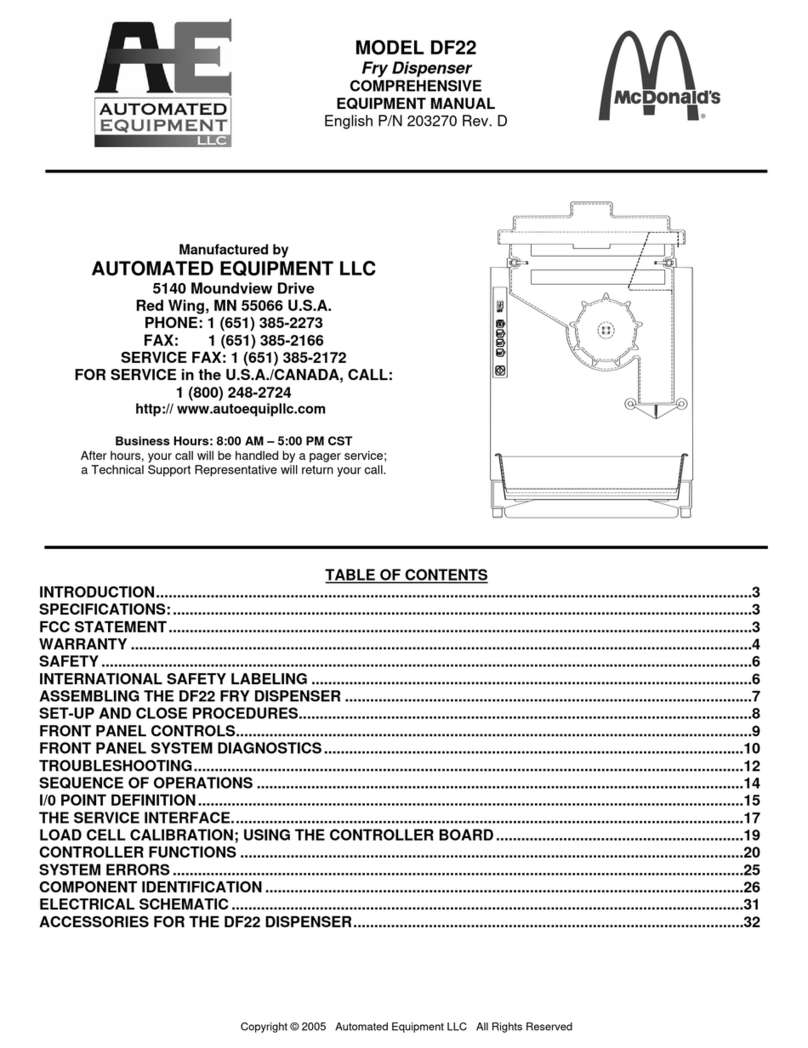
AUTOMATED EQUIPMENT
AUTOMATED EQUIPMENT McDonald's DF22 Equipment manual

JACLO
JACLO Contempo 984-ESSD Series installation instructions
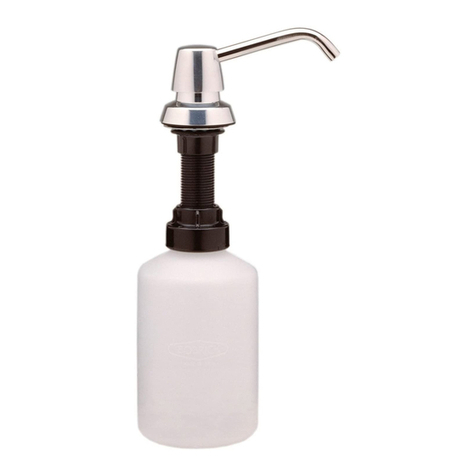
Bobrick
Bobrick 8221 Instruction for installation and maintenance
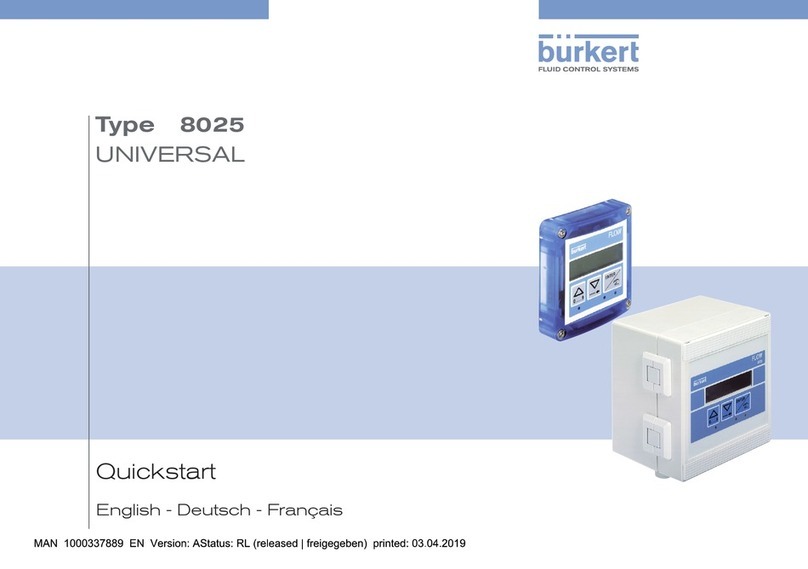
Burkert
Burkert 8025 UNIVERSAL quick start

STIEBEL ELTRON
STIEBEL ELTRON UltraHot Plus Operation and installation instructions
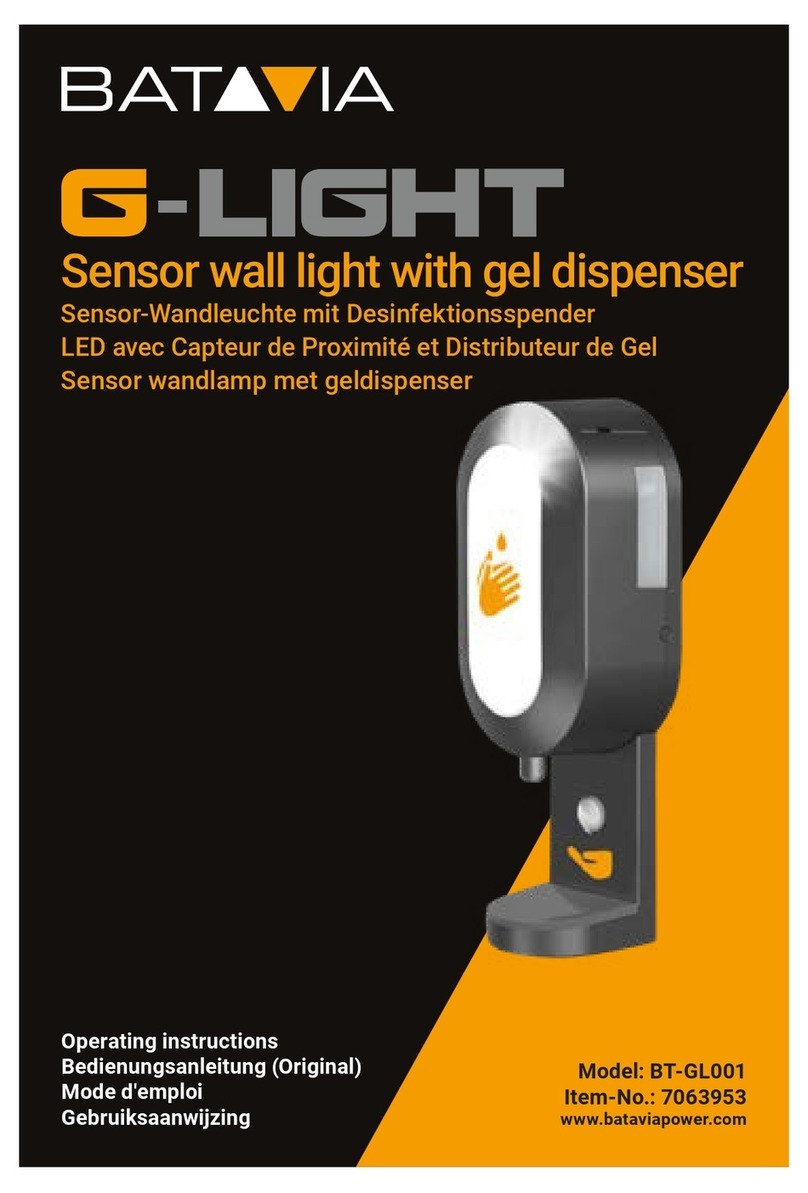
Batavia
Batavia G-LIGHT BT-GL001 operating instructions

